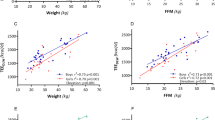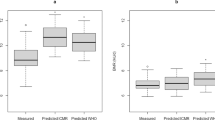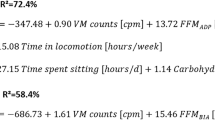Abstract
Background/Objectives:
To test the association between physical activity measured using accelerometer counts (Actigraph) and energy expenditure (EE) measured using the doubly labelled water (DLW) method in free-living children in India. The aim of this study was to explore the usefulness of Actigraphs in estimating EE.
Subjects/Methods:
Total EE (TEE) was measured in 58 children aged 8–9 years over a period of 2 weeks using the DLW technique. Physical activity level (PAL) was estimated from TEE, and the basal metabolic rate was predicted from weight. Physical activity was measured simultaneously using the Actigraph accelerometers (MTI AM7164 and GT1M). TEE was also calculated from the Actigraph counts using a published equation.
Results:
TEE (mean: 6.6 vs 5.7 MJ, P=0.04) and Actigraph counts (counts/minute: 557 vs 465, P=0.02; total counts: 445 534 vs 354 748, P=0.004) were higher in boys than in girls. There were no significant correlations between either total Actigraph counts (r=0.15, P=0.3) or counts/minute (r=0.18, P=0.2), and TEE estimated using DLW. Similarly, there were no significant correlations between Actigraph counts and PAL (r=0.10, P=0.5; r=0.17, P=0.2, respectively). The Bland–Altman analysis showed poor agreement between TEE estimated using the DLW method and TEE derived from the Actigraph equation.
Conclusions:
Activity measured using Actigraph accelerometers was not related to TEE and PAL derived using the DLW technique in children in Mysore. Actigraphs may not be useful in predicting EE in this setting, but may be better used for judging activity patterns.
This is a preview of subscription content, access via your institution
Access options
Subscribe to this journal
Receive 12 print issues and online access
$259.00 per year
only $21.58 per issue
Buy this article
- Purchase on Springer Link
- Instant access to full article PDF
Prices may be subject to local taxes which are calculated during checkout



Similar content being viewed by others
References
Andersen LB, Harro M, Sardinha LB, Froberg K, Ekelund U, Brage S et al. (2006). Physical activity and clustered cardiovascular risk in children: a cross sectional study (The European Youth Heart Study). Lancet 368, 299–304.
Bhave S, Bavdekar A, Otiv M (2004). IAP national task force for childhood prevention of adult diseases: childhood obesity. Indian Pediatr 41, 559–575.
Black AE, Prentice AM, Coward WA (1986). Use of food quotients to predict respiratory quotients for the doubly labelled water method of measuring energy expenditure. Hum Nutr Clin Nutr 40, 381–391.
Booth FW, Gordon SE, Carlson CJ, Hamilton MT (2000). Waging war on modern chronic diseases: primary prevention through exercise biology. J Appl Physiol 88, 774–787.
Cole TJ, Bellizzi MC, Flegal KM, Dietz WH (2000). Establishing a standard definition for child overweight and obesity worldwide: international survey. BMJ 320, 1240–1243.
Corder K, Brage S, Ramachandran A, Snehalatha C, Wareham N, Ekelund U (2007). Comparison of two Actigraph models for assessing free-living physical activity in Indian adolescents. J Sports Sci 25, 1067–1011.
Corpeleijn E, Saris WH, Blaak EE (2009). Metabolic flexibility in the development of insulin resistance and type 2 diabetes: effects of lifestyle. Obes Rev 10, 178–193.
Coward A (1990). Calculation of pool sizes and flux rates. In: The Doubly Labelled Water Method for Measuring energy Expenditure; Technical Recommendations for Use in Humans. A Consensus Report by the IDECG Working Group, ed. Prentice AM: Vienna, pp 48–68.
Elia M (1990). Converting carbon dioxide production to energy expenditure. In: The Doubly Labelled Water Method for Measuring Energy Expenditure; Technical Recommendations for Use in Humans. A Consensus Report by the IDECG Working Group, ed. Prentice AM: Vienna, pp 193–211.
Ekelund U, Sjostrom M, Yngve A, Poortvliet E, Nilsson A, Froberg K et al. (2001). Physical activity assessed by activity monitor and doubly labelled water in children. Med Sci Sports Exerc 33, 275–281.
Ekelund U, Sardinha LB, Anderssen SA, Harro M, Franks PW, Brage S et al. (2004). Association between objectively assessed physical activity and indicators of body fatness in 9 to 10-y-old European children: a population-based study from 4 distinct regions in Europe (the European Youth Heart Study). Am J Clin Nutr 80, 584–590.
FAO/WHO/UNU (2001). Human Energy Requirements. Report of a Joint FAO/WHO/UNU Consultation. Food and Nutrition Technical Report Series 1 FAO: Rome, p 37.
Fox KR, Hillsdon M (2007). Physical activity and obesity. Obes Rev 8 (Suppl 1), 109–114.
Hendelman D, Miller K, Baggett C, Debold E, Freedson P (2000). Validity of accelerometry for the assessment of moderate intensity physical activity in the field. Med Sci Sports Exerc 32 (Suppl 9), S442–S449.
International Institute for Population Sciences (IIPS) and Operations Research Centre (ORC) Macro (2001). National Family Health Survey (NFHS-2), India 1998-1999. IIPS: Mumbai, Maharashtra.
Kapil U, Singh P, Pathak P, Dwivedi SN, Bhasin S (2002). Prevalence of obesity amongst affluent adolescent school children in Delhi. Indian Pediatr 39, 449–452.
Krishnaveni GV, Hill JC, Veena SR, Leary SD, Saperia J, Chachyamma KJ et al. (2005). Truncal adiposity is present at birth and in early childhood in south Indian children. Indian Pediatr 42, 527–538.
Krishnaveni GV, Mills IC, Veena SR, Wootton SA, Wills AK, Coakley PJ et al. (2009). Accelerometers for measuring physical activity behaviour in Indian children. Indian Pediatrics (e-pub ahead of print).
Kurpad AV, Borgonha S, Shetty PS (1997). Measurement of total energy expenditure by the doubly labelled water technique in free living Indians in Bangalore city. Indian J Med Res 105, 212–219.
LaMonte MJ, Blair SN, Church TS (2005). Physical activity and diabetes prevention. J Appl Physiol 99, 1205–1213.
Malina RM (2001). Physical activity and fitness: pathways from childhood to adulthood. Am J Hum Biol 13, 159–161.
Montegomery C, Reilly JJ, Jackson DM, Kelly LA, Slater C, Paton JY et al. (2004). Relation between physical activity and energy expenditure in a representative sample of young children. Am J Clin Nutr 80, 591–596.
MRC Epidemiology Unit, Cambridge. MTI accelerometer analysis software (MAHUffe). Available from http://www.mrc-epid.cam.ac.uk/Research/PA/Downloads.html. Accessed 2 March 2009.
Nilsson A, Brage S, Riddoch C, Anderssen SA, Sardinha LB, Wdderkopp N et al. (2008). Comparison of equations for predicting energy expenditure from accelerometer counts in children. Scand J Med Sci Sports 18, 643–650.
Plasqui G, Westerterp KR (2007). Physical activity assessment with accelerometers: an evaluation against doubly labelled water. Obesity 15, 2371–2379.
Puyau MR, Adolph AL, Vohra FA, Butte NF (2002). Validation and calibration of physical activity monitors in children. Obes Res 10, 150–157.
Ramachandran A, Snehalatha C, Vinitha R, Thayyil M, Kumar CK, Sheeba L et al. (2002). Prevalence of overweight in urban Indian adolescent school children. Diabetes Res Clin Pract 57, 185–190.
Rennie KL, Wareham NJ (1998). The validation of physical activity instruments for measuring energy expenditure: problems and pitfalls. Public Health Nutr 1, 265–271.
Schoeller D, Coward A (1990). Isotope fractionation corrections. In: Prentice AM (ed.) The Doubly Labelled Water Method for Measuring Energy Expenditure; Technical Recommendations for Use in Humans. A Consensus Report by the IDECG Working Group: Vienna, pp 90–113.
Whitaker RC, Wright JA, Pepe MS, Seidel KD, Dietz WH (1997). Predicting obesity in young adulthood from childhood and parental obesity. N Engl J Med 337, 869–873.
World Health Organization (2007). The WHO child growth standards: growth reference data for 5–19 years. Available from www.who.int/growthref/en/. Accessed 2 March 2009.
Wong W, Schoeller D (1990). Mass spectrometric analysis. In: The Doubly Labeled Water Method for Measuring Energy Expenditure; Technical Recommendations for Use in Humans. A Consensus Report by the IDECG Working Group. ed. Prentice AM: Vienna, pp 20–47.
Yajnik CS (2004). Early life origins of insulin resistance and type 2 diabetes in India and other Asian countries. J Nutr 134, 205–210.
Acknowledgements
We thank the participating families, Dr SC Karat, the medical Director of HMH, and Jayakumar, Geetha, Chachyamma, Saroja, Tony Clifford, Kiran, Varnashree, Jane Pearce and Patsy Coakely for their contributions. We also thank Dr Ulf Ekelund and Dr Steve Wotton for their suggestions. The study was funded by the Parthenon Trust, Switzerland, the Wellcome Trust, and the Medical Research Council, UK.
Author information
Authors and Affiliations
Corresponding author
Rights and permissions
About this article
Cite this article
Krishnaveni, G., Veena, S., Kuriyan, R. et al. Relationship between physical activity measured using accelerometers and energy expenditure measured using doubly labelled water in Indian children. Eur J Clin Nutr 63, 1313–1319 (2009). https://doi.org/10.1038/ejcn.2009.95
Received:
Revised:
Accepted:
Published:
Issue Date:
DOI: https://doi.org/10.1038/ejcn.2009.95
Keywords
This article is cited by
-
Intergenerational nutrition benefits of India’s national school feeding program: Reality or a bridge too far?
Nature Communications (2022)
-
Prediction of body-fat percentage from skinfold and bio-impedance measurements in Indian school children
European Journal of Clinical Nutrition (2011)
-
The IDEFICS validation study on field methods for assessing physical activity and body composition in children: design and data collection
International Journal of Obesity (2011)



